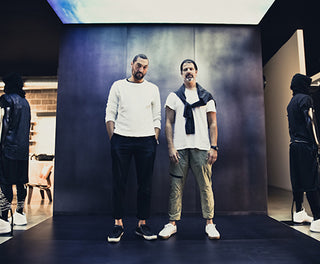BrandBlack is a movement, 20 years-in-the-making, for veteran footwear designer David Raysse. The Paris-born, New York-raised sneaker maestro has spent the last two decades refining his craft through stints at FILA, adidas, and most recently as VP of performance design at Skechers, which saw its profile boosted significantly during this year’s Boston marathon. Having created two of FILA’s most iconic silhouettes of all-time, while still in college – the Grant Hill II and Stackhouse II – David’s infatuation with basketball has led him on a whirlwind journey that’s ultimately enabled him to break away on his own and start a brand that he can call his own.
About a year ago, I got an email about a new footwear venture breaking into basketball. My initial thoughts were to question why an independent would subject themselves to the overwhelming dominance Nike’s had in the basketball landscape; But then I started thinking off all the little guys that have somehow managed to see success through the years – granted, on a much smaller scale. I got some samples sent over to try out, and straight off the bat, the first thing I noticed was a surprisingly great use of quality leather. The soles looked good, the shoes felt comfortable, and overall my perception changed almost instantly. While the design wasn’t my cup of tea, I figured give these guys another year or two and things will definitely start steering in the right direction.
It’s been a year since then, and after exchanging a few emails, I made my way down to El Segundo, in the middle of LA’s aerospace capital which has influenced both the brand’s name, logo and aesthetic, for a meeting with BrandBlack founder David Raysse and Creative Director Billy Dill, himself a longtime veteran of footwear design. While I wasn’t really sure what to expect prior to entering their showroom, I was once again impressed by the improvements and direction the brand’s taken toward providing footwear – and apparel – that can, someday soon, rival the likes of Nike’s NSW and adidas’ Originals collections.
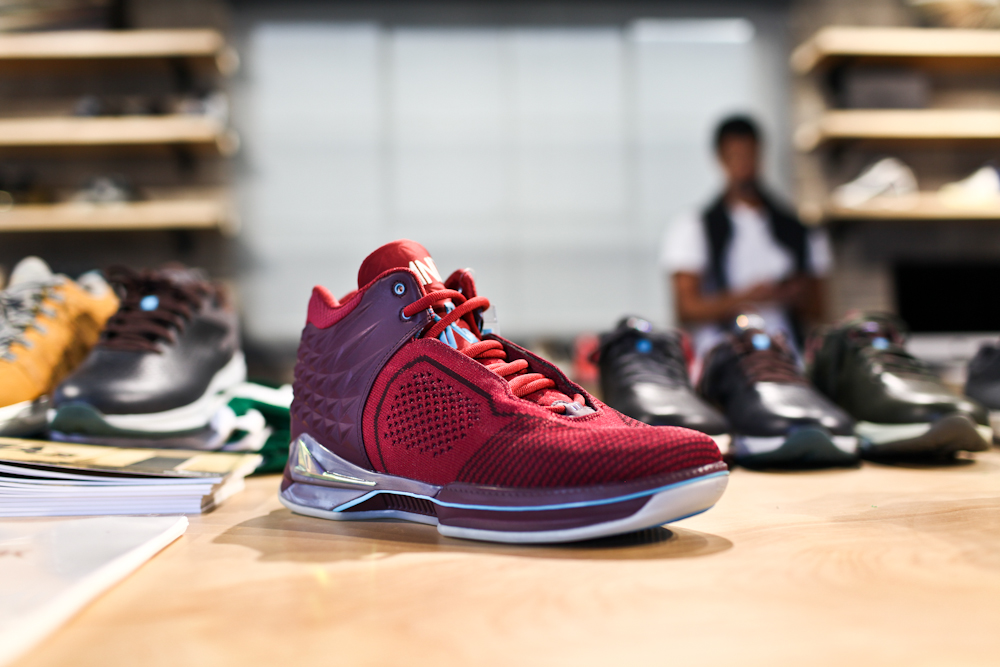
An early look at the upcoming J. Crossover II, designed for L.A. Clippers’ guard Jamal Crawford
COMPETING IN A MARKET DOMINATED 96% BY NIKE
LUIS: After getting a closer look at what you guys are doing for next year, I’d definitely say you’re competing within a smaller micro-market like Nike’s NSW, rather than directly against the huge global category that is Nike basketball. Either way, the million dollar question by most would be, what motivated you guys to enter a landscape so overwhelmingly occupied by one brand?
BILLY: I’ll let him answer, but from my perspective we want to make really pure product that we are into. If we become a 30 billion company, I’m not mad at it – but that’s not the driving force. We want to maintain a good business where we’re proud of what we’re doing, we wake up excited, it fits within our aesthetic and sensibilities… And then hopefully there are other people that join in. What we’re trying to build right now is more than just marketing a sports company, we’re trying to build a movement, in a sense. We’re connecting with core basketball guys and when you’re knocking on that door and going against those guys – those guys get free product all day – so for them to even take your call or put your shoes on and get ridiculed because they’re not wearing a Nike, that’s tough. There’s a lot of guys that have come out, put the shoes on, realize that they perform and they really like them. People are addressing it, it’s starting to percolate on that sports level.
DAVID: First off, I love basketball. I played high school basketball, college basketball, I design basketball shoes. That is my biggest passion. Beyond anything else, I’m going to do something with basketball. I feel like of all the categories it is the one that requires the most understanding of the culture and is the one that most brands get wrong. They all try to do it and they don’t get it. So I felt like if Nike has 96% of the market place that’s absurd. There’s got to be somebody that wants something different. I know that the other clowns aren’t going to do it right. They’re going to do whatever they’re going to do and it’s going to look a little bit like Nike and that’s great. But there’s gotta be room for something different.
So that’s definitely what our thinking was. And to Billy’s point about the movement, Nike is a $30 billion dollar company and they did it exactly how they wanted to do it. They don’t follow other people’s trends – I mean, they do on the bottom stuff, but the big ideas are pure and it’s their thing. I would love to move the entire marketplace to our will in the same way they did. They took the adidas milkshake and they drank it. They took their aesthetic and just bent everybody to their will – I would love to bend people’s wills.
One of the reason we started this is we were thinking Nike is the victim of their own success. They’re so big, so successful – there’s got to be people that just want to wear something different. Not by any fault of theirs, just that they’re too awesome and there’s too much of it out there. At a certain point, there’s got to be somebody that’s like, “I want to wear something different just because my mom, dad, grandpa, cousin, everybody has the same brand on.”
That was one side. Then the other side is that we felt like youth culture is – recently I feel like more than any other era, especially in hip-hop which is what I’m closest to – it’s the first time that they’re totally irreverent and have no respect for the older generations and don’t really care about it and the music has just shifted completely where it’s like, “You know what? Fuck Jay Z, fuck all your albums, don’t really care.” [Laughs] “I’m going to listen to trap music and I don’t really care how awesome you were back then because it’s completely irrelevant nowadays.” And even the aesthetic, though – you get people that are like, “Fuck that, I’m not wearing skinny jeans.” So I felt like these kids are ready for a new brand. I think we can be part of that movement, hopefully. [Laughs]
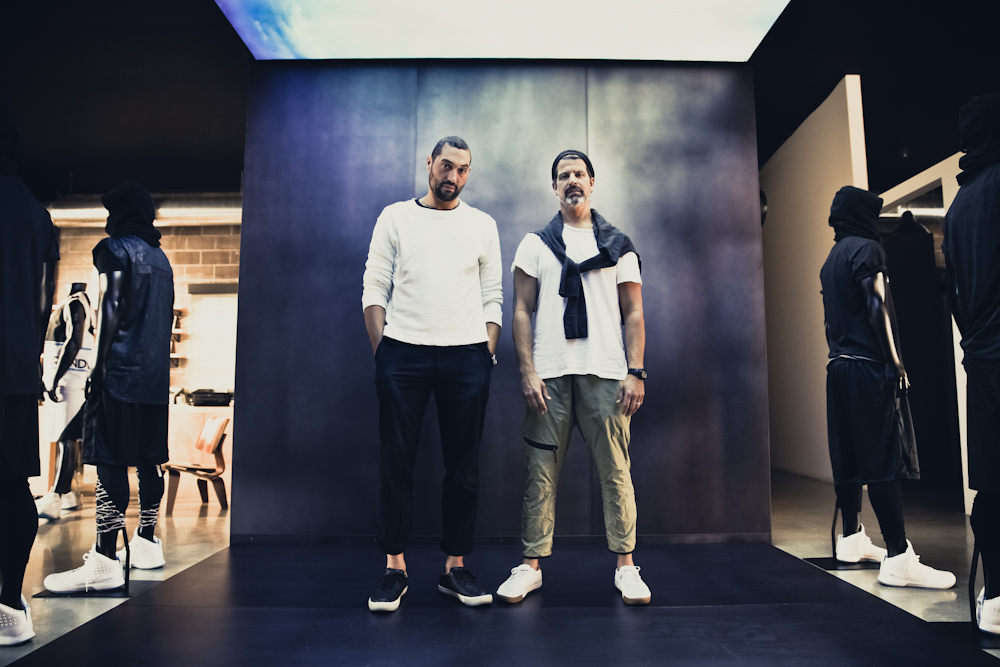
BrandBlack founder David Raysse and Creative Director Billy Dill
FOOTWEAR BEGINNINGS
How long have you been working in footwear design for?
David: I’ve been doing this for over 20 years. I started with FILA in the ‘90s when I was in college. I designed the Grant Hill II when I was 22.
I loved that shoe.
David: That was nuts at the time for me because I was very close to the demographic that was buying it, so it was really cool. I remember I’d be on the subway – I lived in Brooklyn at the time – I’d be going on the A Train and there’d be these thug kids. I remember they’d be looking at me like, “Look at this dude.” But they’d have my shoes on. [Laughs] I worked at adidas after that. I was head of basketball. That was good because I learned a lot, because the Grant Hill – even though I love it – is a fucking terrible basketball shoe. It looks really nice, but do not try to play in it!
I learned a lot about making shoes at adidas. I also learned about having any kind of purity beaten out of you. [Laughs] They are a marketing company, so it’s tough to get through that. I think anybody that’s worked in an industry has that part beaten out of you on some levels because that’s sort of what marketing does. Marketing identifies something that works and then no matter what pure idea you have, they’ll say, “Well take this idea and supplement it on top of whatever pure thing you have.” The sad part is that it works, that’s why there is one. So it’s tough to rinse that off.
It took awhile. I got to work with Philippe Starck and that was his criticism of me many times. [Surprisingly good French accent] “Fuck this marketing bullshit, you have to get away from it.”
And I wasn’t really able to understand what he was really talking about – it took awhile. It took a long time to grasp that because it’s really beaten in to you. US culture is all about that, too: Whatever works, works, so do it. If anything comes of this brand, I think just being able to have pure ideas again is really refreshing.
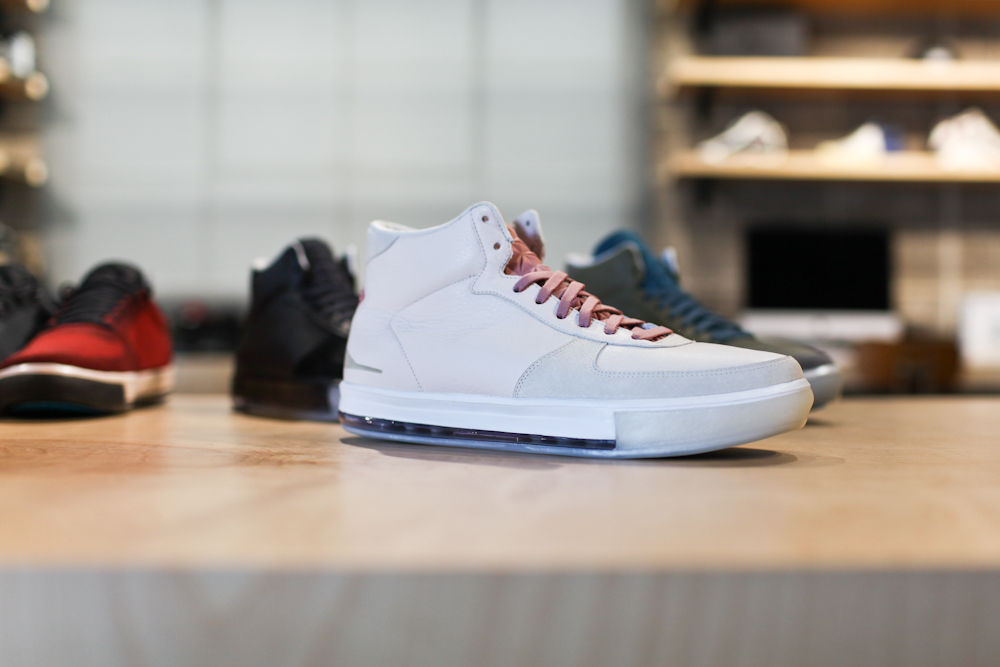
BrandBlack introduces the Jet Mid into its stable of 2015 premium lifestyle designs
DESIGNING WITHOUT ALL THE MARKETING
Why do you feel marketing impedes when it comes to pure design?
DAVID: I think that at it’s core, what marketing does is identify. Let’s say they say, “Okay, right now. Neon’s really working and kids like something trendy.” So you’ll come up and be like, “I want to come up and do a shoe that’s all white, doesn’t have any crap on it, and is really pure.” They’d say, “That’s great. However, if you stuck neon on the front of it, it would sell better.” So all of a sudden, if your idea was all about taking things away – which probably could have been successful had it been channeled in the right way – it ends up veering off in a way that isn’t that idea anymore.
So, I guess what I’m saying is that I’m not anti-marketing, I just wish that marketing was more nuanced sometimes and they would identify what they have in front of them and do it the way that it should be done. If you look at when Apple was blowing shit up and killing it, it’s because they were saying, “Great, everybody’s doing this. So we’re going to do this and we’re going to do it well, it’s going to be focused and marketed and targeted and we’re going to look at our consumer with what it is. But we’re going to do it a way that’s specific to that idea.” And I feel most brands don’t do that – most companies don’t do that.
There’s no longevity.
David: There’s no longevity. That’s another one, too, I feel like there’s so many brands that have one idea, they fall in love with it, and then that’s it. They don’t want to do something new. And maybe that’s because they’ve become a victim of their own success?
Billy: That’s why Nike’s so good. Nike’s playing chess, everybody else is playing checkers. Nike’s light years ahead in terms of their strategies and thinking. They’re not a one-trick-pony, they’re always trying to push it. The smaller guys have difficulty because they don’t have a staff or everybody’s wearing a bunch of different hats or whatever it is, but you get locked into that idea and that’s all you see. Then when it’s gone, you’re the guy chasing the dragon. Now you’re the guy that’s chasing after everybody else. Then you’re the guy who looks like another bad B-version of that.
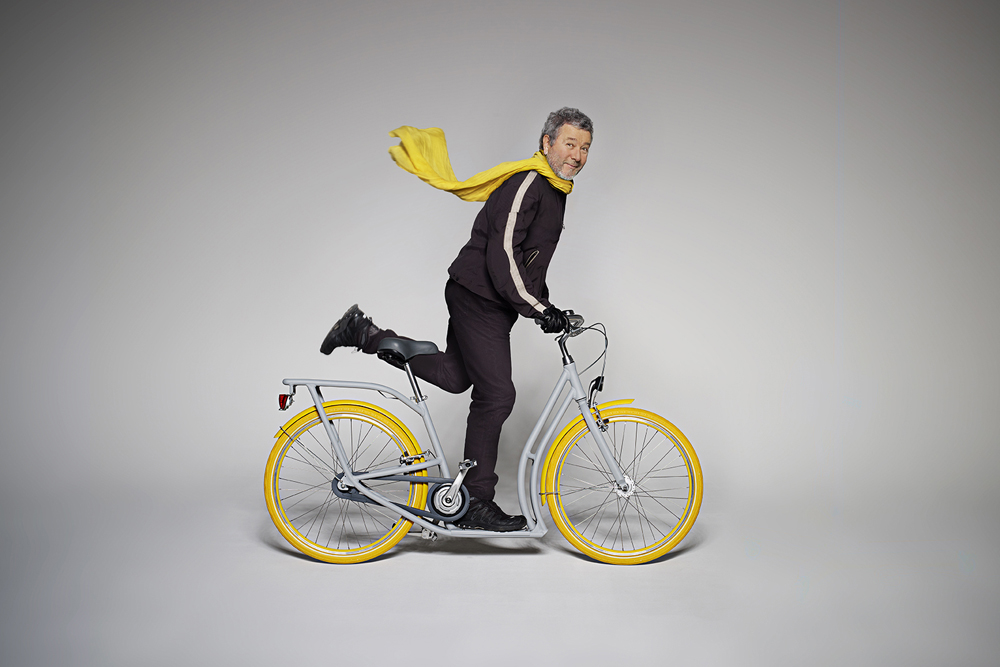
Legendary French designer Philippe Starck
LEARNING FROM ICONIC DESIGN GURU PHILIPPE STARCK
How much of your personal style is influenced by having worked under such a prolific designer like Philippe Starck?
DAVID:There’s a lot of heroes that you have in your life, and when you finally get to meet them, you’re always disappointed like, “Wow, that guy’s actually not awesome at all.” [Philippe] is 100% the real deal, which was nice to see. I’ve never met a designer that saw the big picture as much as he did.
He didn’t just see the finished product, he saw the context it would be in, how it would affect people. He’s great and super pure. Like I said, his thing about [marketing] I think that that’s definitely had a huge influence on my aesthetic. Not in the sense of me changing my personal aesthetic, but maybe me finding my voice better and listening to it more. I think that’s the hardest for a designer. That would be my advice that I would give to anybody, “Just don’t lose sight of that.” I did for awhile. I think a lot of people do.
UTILIZING ONLY PREMIUM MATERIALS
After holding some of these new designs, I can tell the quality is definitely there. I know the Jet model is produced within the same factory that makes Prada footwear. Can you talk about the importance of using such high quality components?
DAVID: That goes to the philosophy of simplifying the product so that instead of spending the money on lots of junk and tricks on the shoes, you can spend the money on materials. The factory that I’m making the shoes in is really good. Really, really good. They’re able to make high quality product. It took us two years of working on the shoes, we have really good development, it requires a whole team to do good product. That’s why I think you see a lot of small brands where the product’s not very good because oftentimes they don’t have the expertise. They’re usually just working through an agent and the agent just makes the shoes and gives it to them.
BILLY: That really is a premium leather for a basketball shoe and it’s light.
DAVID: A lot of consideration goes into the lining constructions, the foam paddings – we worked on the tongue of that [upcoming sneaker] for six months. On this new fuse tongue.
BILLY: Take a look at the interior. Every single little detail is considered. This is based on Jamal’s comments from the first one. One of his major complaints was that it wasn’t the most breathable shoe. So obviously, we went with a woven [upper]. Another thing is, being a smaller company there aren’t as many egos in our room. So David has a direct line to Jamal, our athlete, who has first and foremost in terms of how to build the shoe for him.
Then we got a guy like [Nightwing2303] who is a really big wear tester, he has a lot of good input. We ask him, unbiased, “Tell us what you think of this shoe. Does it suck? You can say that.” He’s the kind of guy that will say that. “But also tell us what you would improve or what you feel is really good.” And we listen to that. All of these things from a wear tester of that caliber, or Jamal, or whoever – these details get talked about and then the shoe changes. I could pull another shoe over there that aesthetically looks the same, but there’s so many changes in it that you wouldn’t even know. It’s all based on these experiences. Every little detail has to be thought through. And a lot of times with the bigger guys it’s like, “We just need a follow up for that shoe, let’s just pump it in, it looks cool, it’s light, okay cool, let’s get it going.” Then the molds are being done and there’s probably two or three shoes in all the offerings that where really, really major details worked out.
But the general basketball shoe by any brand is just whatever; it’s not that special. We only need to make three basketball shoes per season that are high quality so we want to make sure every detail is considered and every piece is touched on. And there’s a huge difference between those two particular shoes even though the tooling is the exact same. Aesthetically they’re different, the material is different, the tongues are different.
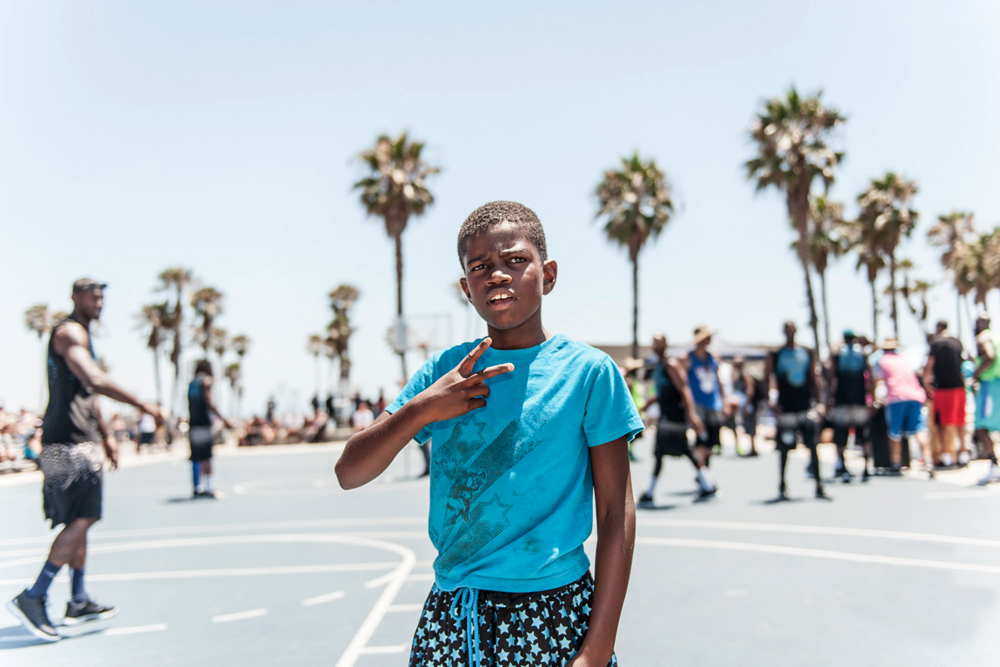
BrandBlack making a positive impact at the Venice Basketball League (Photo courtesy of Cliff William)
GRASSROOTS INITIATIVES
Something that’s helped companies, including Under Armour, have been grassroots initiatives. Is that something you guys are currently developing?
Billy: We’re knee deep in it. We sponsor the VBL which just won the whole Venice Basketball League for the summer; undefeated. In all of the history of Venice basketball, they were the first team. So these guys are really, really great and we’re developing teams to get in tournaments. We’ll bring someone on probably as early as next week and start funneling that. We’ve got a lot of reach outs from everyone from high schools to urban community centers. We’re definitely huge on that. So on one level, on the retail side, we’re shooting for the premier top tier retailers globally. And then on the other side we’re going super grass roots, down and dirty into the high schools. Find the best ballers, put the shoes on their feet, and let them get out there and play in them.
So people who are thinking this way aren’t thinking that way and vice versa, we’re trying to attack on both levels. Both levels are really important to us. Because this elevates into a category that we want to be in but at the same time we want real ballers and people that are into the brand to be able to receive it, understand, and try it.
David: We also worked with all of California’s top high school kids, we went to a dinner with them and talked to them. The AAU world is a murky opaque world. It requires bringing the right people on board because you can get in trouble really quickly and there’s NCAA eligibility and all that stuff. You have to be careful. Even when we did that we couldn’t give them shoes at the dinner. It’s very challenging.
Billy: Another difficult part is you can’t find these shoes in the wild. For sure right now because our retail arm is just not really there. I get them all day long through the IG account or through the emails or whatever. Kids show up at the basketball tournaments and are like, “I want to get your shoes! How do I get you shoes?” Jamal Crawford, who we haven’t talked about, has half a million Twitter followers and he’s just the most genuine, humble, awesome guy on the planet. He has a fan base that’s incredible. These guys want his shoes.
How are you going to sell a $150 basketball shoe that nobody has ever seen in the wild? And we’re selling – I’m not going to tell you the exact numbers and it’s not like setting the world on fire – but we’re selling shoes to these guys online, sight unseen and have never tried on before. That’s huge, that’s really difficult to pull off. But it helps if you’ve got the best baller that’s on the court in community A, he walks out and you’re like, “First of all, what is he wearing?” “Second of all, how did he just do that on three guys?”
David: It’s the celebrity endorsement thing that we talked about. The same thing. At the end of the day you’re going to look at the shoe and if it’s just the A guy wearing it you’re going to be like, “Well, he’s just paid to wear it. He’s probably not even wearing a shoe that they sell.” So I think it’s important to have local guys. We had a couple of the draft class from the NBA wanting to get down with the brand, but I don’t have those kinds of pockets. [Laughs] They’re interested and they know about it. All the young kids knew about it, which is nice. We’re going in the right direction, which is key.
Billy: It’s a skeleton crew, it’s a small operation, we’re just building right now. And it’s more than the people in this room can deal with. But like I said, we’re going to bring somebody on who speaks the language and understands the core community. Hopefully by bringing somebody like that on we can continue to build. And on the grassroots side, our arms get a lot stronger and it legitimizes the brand as performance because if they don’t work, athletes aren’t going to wear them. People want to win. That’s what makes you a great athlete; you’re not going out there to get second.
BrandBlack’s promotional commercial for Jamal Crawford’s first signature sneaker, the J. Crossover
FASHION VS. FUNCTION
Would you guys consider yourselves a fashion basketball brand? Or a basketball brand that’s fashionable?
Billy: We’re performance at the core. We’re deeply seated and basketball is our core, but just performance athletic is what we are as a brand. We stand behind that, everything has a performance value built in. The aesthetic – we want to be a younger and more contemporary spin on athletics. Nike does what they do really well. They have a small section that’s really sexy and smart but that’s a really, really small piece of their business. And it should be because that’s what starts the trends. But then you’ve got adidas, Reebok, Under Amour that’s coming up – they all have a defined idea.
Let’s use Under Amour as an example. You’ve a Nike brand and a Nike NSW and then you have the Under Armours of the world. I don’t want to wear a tight shirt, I play sports, but that’s not my aesthetic. And I can’t afford an $800 jacket from Nike in Italy. So I feel like there’s a piece in the market for younger perspectives in terms of athletics and that’s what we want to come in as. Just a fresher version of it. This is something we always talk about. In athletics, for some reason, it’s completely appropriate for a 40-something year old father and his 16-year-old kid – say they’re hooping or they’re in the gym – they’re wearing the exact same kit. It’s totally appropriate.
Doesn’t happen in music, they get in different cars when they leave, they go eat different places, they probably don’t see eye to eye on politics, they probably hate each other on a lot of levels. But for whatever reason, that’s been appropriated and is totally fine. A lot of that is business.
David: For a new brand to come out with a different aesthetic. I think, where we’re headed, is less noise. It’s like if Common Projects made performance products. That’s the direction that we’re going in, that’s the aesthetic that we like and I think if you look at athletics – that’s what it used to look like. If you look at retro product, if you look at Adidas originally, that sort of simplicity and purity – there’s no reason you can’t make that functional. The aesthetics of the shoes today has nothing to do with the function, it just is what it is.
Also, I’m old enough – grandpa over here – to remember the catalogues. I would sneak into Footlocker and I was cool with the clerks in there and they would show me the catalogue before the Jordans came out. I remember you’d look at it and be like, “That thing looks retarded. And not in a cool way, it just looks terrible. I don’t know who the hell is going to wear that.” And then when it came out, you were still like, “Ehh, it doesn’t even look like a sneaker!” I remember I used to always say it looked like a boot or something. But then it would slowly start to slowly seep into you.
Billy: Or you see a guy that can rock it right and you’re like, “Oh, I get it now!” It took a minute. And I think you touched on that earlier with brands, a lot of times they have an idea and when they’re pushing to do something different, there’s a lot of haters. A lot of people going, “I don’t get it, that’s whack.” Blah, blah. Unless, of course, it’s a really big brand with a lot of credibility and then it’s a sheep at that stage. But as it starts to form, you can look back a year later and be like, “Oh, that’s my whole shit right now. I’m on that.”
David: Toms did it. Say what you want about that brand but when you first saw those shoes first come out you were like, “What the fuck?”

TOUGHEST PART ABOUT LAUNCHING A BRAND
David: I think the hardest thing for us is just the drudgery stuff. The stuff you wouldn’t put on the reality show because it would be fucking boring as hell. Dealing with invoices.
Billy: And the timeline for footwear – especially for athletic footwear – because it’s complicated, it’s very technical, there’s a lot of testing involved. From concept to fruition, that’s a pretty big stretch. Like, David is working on Spring ’16 right now. But knowing the way he thinks, being a creative, he’s got these concepts and he’s really pumped, I was in his office this morning and he’s like, “Wow, look at this, this is really amazing.” By the time that gets to sample and goes through a couple stages of development and then testing and blah, blah, and then it’s on a salesman’s floor and he’s selling it, he’s so tuned out of that he doesn’t even want to look at it.
David: That’s why Nike’s been so successful. That’s also why you need a very pure personal idea. Because the time frame that it takes for it to get to market is so long that if you’re going to try and follow a trend, it’s going to be off trend by the time it reaches market. So it’s better that you do something that’s fucking weird and hone it in there. It’s almost like you start with something that’s just ridiculous, and then you try and make it functionally work and also resolve it as a design. I think that’s another thing that we talk about a lot. And that’s another thing that brands are that are successful strive to do and ones that aren’t don’t is that – it’s another thing as a designer who has worked in an industry, you sort of push to the side is taking risks and doing things that are awkward. Accepting that and the ridicule that comes with that because it leads to something much better.
If you look at the first collection that we did, I wouldn’t rock any of that shit, it’s not my aesthetic at all. But it was a good way to break chunks off of the sound and feel of what I’m doing to get to a new place. That’s one thing that brands that get successful don’t do, they get into their comfort zones. It’s like a recording artist when they get the deal and they can do whatever they want and then every album is trash after that.
Billy: Or the album is five years in the making and everyone’s over it and like, “I don’t care if it comes out.” [Laughs]
As a designer are you ever fully satisfied?
David: No. [Laughs] I guess I’ve gotten better at accepting that sort of thing. It’s a memory in time, it’s a snap shot. If you tell me you have to do an update to that shoe there will never be a time where I’m like, “No, it’s perfect.”
That goes with everything. There’s always something you could change.
David: You just reminded me of my favorite quote of all time, which goes with our design aesthetic. Mark Twain, “If I had more time I would’ve written a shorter letter.” [Laughs] I love that quote, it just says it all.
::
::
Brandblack.com
BrandBlack on Instagram (@brandblack)
BrandBlack on Facebook (HERE)

